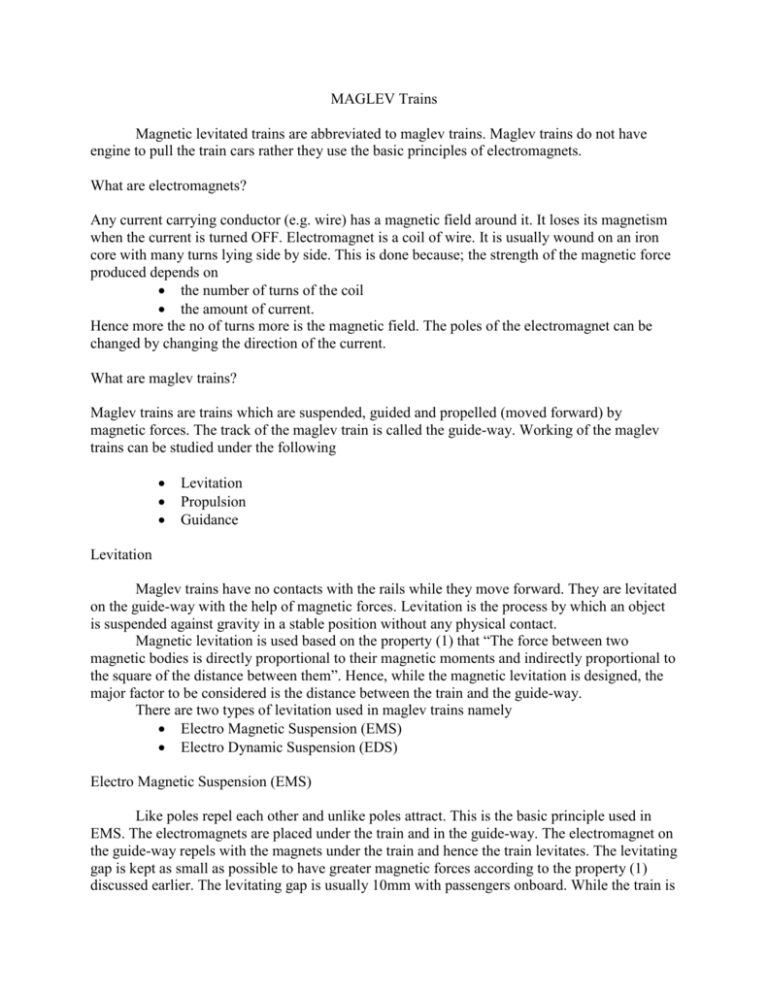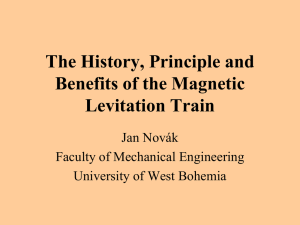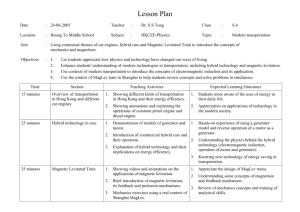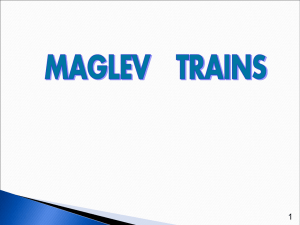MAGLEV Trains Magnetic levitated trains are abbreviated to maglev
advertisement

MAGLEV Trains Magnetic levitated trains are abbreviated to maglev trains. Maglev trains do not have engine to pull the train cars rather they use the basic principles of electromagnets. What are electromagnets? Any current carrying conductor (e.g. wire) has a magnetic field around it. It loses its magnetism when the current is turned OFF. Electromagnet is a coil of wire. It is usually wound on an iron core with many turns lying side by side. This is done because; the strength of the magnetic force produced depends on the number of turns of the coil the amount of current. Hence more the no of turns more is the magnetic field. The poles of the electromagnet can be changed by changing the direction of the current. What are maglev trains? Maglev trains are trains which are suspended, guided and propelled (moved forward) by magnetic forces. The track of the maglev train is called the guide-way. Working of the maglev trains can be studied under the following Levitation Propulsion Guidance Levitation Maglev trains have no contacts with the rails while they move forward. They are levitated on the guide-way with the help of magnetic forces. Levitation is the process by which an object is suspended against gravity in a stable position without any physical contact. Magnetic levitation is used based on the property (1) that “The force between two magnetic bodies is directly proportional to their magnetic moments and indirectly proportional to the square of the distance between them”. Hence, while the magnetic levitation is designed, the major factor to be considered is the distance between the train and the guide-way. There are two types of levitation used in maglev trains namely Electro Magnetic Suspension (EMS) Electro Dynamic Suspension (EDS) Electro Magnetic Suspension (EMS) Like poles repel each other and unlike poles attract. This is the basic principle used in EMS. The electromagnets are placed under the train and in the guide-way. The electromagnet on the guide-way repels with the magnets under the train and hence the train levitates. The levitating gap is kept as small as possible to have greater magnetic forces according to the property (1) discussed earlier. The levitating gap is usually 10mm with passengers onboard. While the train is moving, the electromagnets are magnetized and when the train has to be stopped, just the current is turned off to demagnetize the magnets. The train stops and rests on the guide-way closing the gap. The magnets are placed in the form of C under the train as shown in the figure (i). The repulsive force acts on all the three edges of the C-shape and helps in better levitation. The major factor to be considered while designing the magnetic strength is the earth’s gravity. As already mentioned, the magnetic strength depends on the amount of current. Hence, to make the train levitate against the gravitational pull, large current is required to create a strong repulsive magnetic force. Study shows that to maintain a gap of 50.8 mm 50,000 ampere turns of magnetic strength has to be supplied. Magnetic intensity (strength) = N × I Where, N – Number of turns of the coil I – amount of current Hence, to maintain a gap of 50.8mm in a coil with 1000 turns (assumption) 50 amperes of current has to be supplied. The train moves at a speed of 400 km/hr. The maintenance of a very small levitating gap at higher speed using EMS is challenging. The monitoring and control of the gap is very difficult at higher speed. Hence, higher speeds cannot be achieved in this design. Electro Dynamic Suspension (EDS) EDS was discovered by Japanese while EMS by Germans. By using EDS, much higher speeds can be attained. The fastest train running in the world uses EDS principle and runs at a speed of 581km/hr. However the train has to be run on wheels till it gains a speed of 100 km/hr, only after which it can be levitated. In this system the track is called inductrack. Electro dynamic suspension system has electromagnets on the train. The inductrack has an array of electrically shorted circuits (coils connected in series from the start of the track till the end). According to Faraday’s law of electromagnetic induction, whenever there is a change of flux linked with the coil, an emf (current) is induced in the coil. When the train starts to move on its wheels, the magnetic flux linked with the coils in the inductrack changes and hence an emf (current) is induced in the coils. As already discussed, every current carrying conductor has a magnetic field around it. Hence, there is a magnetic field developed around the coils in the inductrack. This magnetic field opposes its cause i.e. the magnetic field in the train (by Lenz’s law - when a current is induced in a conductor it is in such a way to oppose the cause). Therefore, a repulsive force is produced between the magnetic field of the train and the track and the train levitates. The electromagnets in the train are superconducting electromagnets. Superconductors are materials whose resistivity (Resistivity is how much a material opposes the flow of current) becomes zero when they are cooled to critical temperature. Critical temperature is the temperature at which the matter has no distinction in its states. For e.g. at critical temperature of nitrogen, nitrogen is neither a gas nor a liquid, but has both the characteristics of gas and liquid. Superconducting electromagnets are used as the coils of these electromagnets can carry huge amount of current as the resistivity is almost zero. Hence, the magnetic force is higher and hence higher speed is achieved. Here, as the power is supplied only to the electromagnets in the train, this system consumes less power compared to EMS system. In EDS system the levitation gap is 10 cm. Though the distance between the two magnetic bodies is larger, the magnetic force produced is huge because of the use of superconducting magnets. Therefore, this system does not require any control and monitoring of the levitating gap. Propulsion Propulsion is moving the train forward. To propel the vehicle, the electromagnets are placed on the sides of the guide-way. They are energized according to the time when the train reaches that particular spot and are de-energized the rest of the time. In figure (ii), at step 1, position 2 pushes the train due to repulsion of poles and position 3 pulls the train front due to attraction of poles. So the train moves forward. At step 2 the polarity of the coils in the guided walls changes. By doing so the train is again pushed forward making a complete motion. Guidance The propulsion coils are used for guidance. The propulsion coils are placed on the left and right side of the guide-way as shown in figure (iv). Emf is induced in the coils when the train is moving, the same principle on which EDS works. The coils are connected and hence the emf on either side of the train are opposite in direction. Hence, they cancel out each other. Thus the train moves in the centre of the guide-way. When the train deviates from its centre position i.e. when it moves towards one of the walls, one of the emf is greater than the other and the resultant emf directly depends on the difference in distance. As, there is an emf, a resultant magnetic force is also produced. Hence, the magnetic force due to emf depends on the difference in distance. This resultant magnetic force called the guiding force pushes the train to the same distance and thereby putting in the centre. Figure (iv) Maglev trains are mainly used for transportation in china, japan, germany,etc. It is still not used by many countries. This article has just briefed the basic principles and working of the maglev trains. Maglev trains are the best example of the modern transport means. If solar panels are installed above the guide-way all the way along in maglev trains, they can also help in saving world resources!






